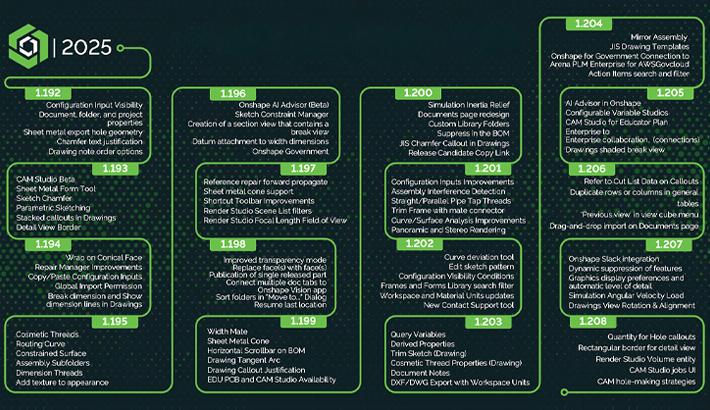
4:34
The more agile and resilient manufacturing companies are always striving for incremental improvements.
In The State of Product Development and Hardware Design 2021 report, an independent industry survey commissioned by Onshape, we asked nearly 800 engineers, project managers and executives to identify the product development processes they believe need the most improvement. Their answers are represented in the word cloud below:

The larger the word appears in the cloud, the more frequently it was selected as an area for desired improvement. Note that critical process areas – such as communication, collaboration, access and management – are mentioned as problem areas as often as design tools and technology (CAD, PDM, PLM).
Many of these keywords are related to data management challenges, including the pros and cons of external add-on PDM/PLM systems and the difficulty engineers often have locating and accessing the correct design file at the moment they need it.
Areas of Importance vs. Current Capabilities in the Project Development Process
Further exploring these top priority areas for improvement, we asked survey participants to identify which elements of the product design process are the most critical to their company’s success – and then we asked them to rate their own team’s proficiency in those same areas.
In nearly every identified priority area, companies report they are falling short of where they know they need to be. This pattern of dissatisfaction is consistent across product development processes and design tools/technologies. No one gave themselves and their colleagues a perfect score.
To create the comparison chart below, we asked:
- (Green Bar) How important are each of the following to the success of your company’s product development process?
- (Black Bar) How would you rate your company’s current abilities in each of these areas.
The Gap Analysis: The priority areas are listed in order of the respondents’ perceived importance in the product development process.

It is striking to note that all of the top 10 most important priority areas concern product design processes (communication, data management, collaboration) as opposed to software functionality.
However, a more compelling story can be told by comparing the lengths of the black and green bars – the gap between a company’s current abilities and the critical area’s level of importance.
We call this deficit the “Capabilities Gap,” which measures the difference between how successful a company wants to be in a specific area versus how successful they actually are at the moment.
For example, 82% of respondents said they considered “minimizing time spent on non-design related activities” to play a very important or somewhat important role in the success of their product development process. But only 40% of those same professionals believe their companies are doing an “excellent” or “good” job at achieving that objective. Employees are becoming increasingly dissatisfied with complicated tools and processes that sap productivity and job satisfaction.

The Capabilities Gap: How Companies Judge Actual Performance vs. Desired Goals
Using this same formula, the five product development areas where teams report they need the most improvement in 2021-2022 are:

Design teams want more time to actually design and want to spend less time managing data. They want earlier communication and transparency beyond the core design team to include the perspectives of other internal stakeholders and outside partners. Earlier collaboration often results in considering more alternative ideas and increasing the likelihood of innovative improvements.
Get Your Copy of “The State of Product Development and Hardware Design 2021”

Interested in learning more about potential areas of improvement for your product development team? In addition to exploring the Capabilities Gap, this 2021 industry survey also offers insights on the following topics:
- The Perception Gap – Executives consistently have a rosier view of their design capabilities than project managers or individual contributors. These differing perspectives about team strengths and weaknesses could possibly lead to unrealistic timetables for delivering on deadlines – or be a sign of poor internal communication.
- Reducing Wasted Time – 85% of teams say they sometimes can’t access the correct version of their design data; while 83% say they sometimes can’t even find it in a timely manner. Another 71% of teams say they have lost work due to CAD system crashes and data corruption.
- Data Management Challenges – Half of on-premise PDM/PLM users say that their software gets in the way of team collaboration and slows down the overall product design process. While 45% say PDM has only replaced one problem (version control) with another problem (delays).
- Workplace Flexibility – Companies that view themselves as “highly productive” are better at supporting “work from anywhere.” While 74% of high-productivity companies say they are good or excellent at giving employees flexibility for when and where they work, only 41% of average or low-productivity companies give themselves similar marks.
- Pandemic Impact – As a result of the product development lessons learned from the COVID-19 pandemic, 63% of engineering professionals say remote collaboration tools are now more of a company priority. Another 58% of respondents say they now have a greater need for seamless access to design documents from any location.
- The Generation Gap – Across multiple categories, Millennial and Gen Z engineers give their employers lower scores for offering workplace flexibility and for enabling real-time access to information than their later-career colleagues. This perception gap is important for executives to consider as they think about their future recruiting efforts.
Download your free copy of The State of Product Development and Hardware Design 2021 today and discover the best opportunities for improving business agility.

Latest Content

- Case Study
- Consumer Products
How K2 Skis Accelerated Product Development by 25% with PTC’s Onshape
01.14.2026 learn more

- Blog
- News from Onshape @ PTC
Onshape at CES 2026: Where Innovation Meets the Show Floor
01.05.2026 learn more
- Blog
- News from Onshape @ PTC
Onshape’s Top 10 Best and Newest CAD Design Software Features of 2025
12.23.2025 learn more



